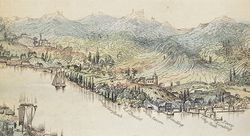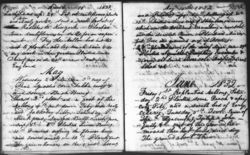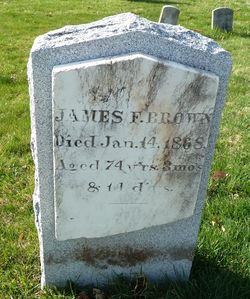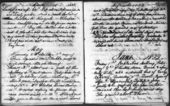James Francis Brown
James Francis Brown (c. 1793–1868) escaped slavery in Maryland in 1828 and purchased his own freedom by working for the Verplanck family in New York, eventually becoming their head gardener. His diaries document the daily lives of people who constructed and maintained the elaborate gardens and landscapes commissioned by wealthy residents of the Hudson Valley in the mid-nineteenth century.
History
James Francis Brown, also known as Anthony Chase and Anthony Fisher, was born in slavery around October 1, 1793, in northern Maryland.[1] Little is known about his mother. His father, Robert Chase, was also enslaved, but died a free man on July 22, 1838.[2] The historical evidence concerning James F. Brown’s early life is difficult to follow, and sometimes contradictory. Historian Myra Armstead convincingly argues that he learned how to read and write at one of the German Lutheran churches in Frederick County in his youth.[3] She speculates that Brown may have been owned by Matthew Brown, a farmer and co-owner of a wool processing factory, before Brown was sold to the farmer William E. Williams (1797–1822).[4] While working for the Williams family in 1818, James Brown was recorded on the Baltimore city tax list, residing on Frederick Street, where he may have enjoyed a “quasi-free” status.[5] In 1826, in anticipation of his own promised manumission, Brown married and paid for the manumission of a woman named Julia Chase (also known as Julia Williams), but upon the death of Henry Lee Williams, Brown’s new mistress Susan F. Williams refused to free him.[6] In 1827, Brown and his wife ran away from slavery.
By March of 1828, eight months after he fled Baltimore, Brown was living in New York City and working as a coachman and waiter for the judge and former congressman Daniel C. Verplanck (1762–1834). When Brown was recognized and his whereabouts made known to Susan Williams, Verplanck offered to pay her a security bond until Brown was able to purchase his own freedom for 300 dollars over the course of three annual installments.[7] Brown earned this money working as a waiter, coachman, and gardener for Verplanck and his family, first in New York City, and later at their Hudson River estate Mount Gulian in Fishkill (modern Beacon) [Fig. 1]. In 1829, he began a series of diaries that he would continue until 1866, which provide almost all of the surviving historical evidence for his life [Fig. 2].[8] Between 1831 and 1832, Brown took a year-long hiatus from his work for the Verplancks, during which he lived and worked in New York City with the lawyer and anti-slavery activist Peter A. Jay (1776–1843).[9] Upon his return to the Verplancks in 1832, Brown dedicated himself to gardening, and was promoted to the position of head gardener at Mount Gulian in 1836 [Fig. 3]. Daniel Verplanck had died in 1834, so Brown answered to his forty-three-year-old daughter Mary Anna Verplanck (1793–1856) in his new role. Brown’s duties always included tasks like running errands for the family and transporting them across the Hudson river to Newburgh, but as head gardener he also supervised other employees in the gardens and grounds of the estate.[10]
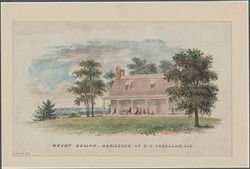
The garden at Mount Gulian was already established by the time James F. Brown started work there in 1829. First laid out by Daniel Verplanck in 1804, it was about six acres in size, with formal flower beds near the main house, a wooded area, a brook, a pond, and long lawn providing a view across the Hudson.[11] Although Brown never set out to describe Mount Gulian in his diaries, his records nevertheless constitute a valuable source for reconstructing its early design. One entry from 1836 notes “laying out walk round the brooke in the garden” while an 1838 entry records that “Doctor VP and Mrs. VP layed out a circular roade in front of the house and layed some grabel [gravel] on it” (view text).[12] Another 1838 entry, one of only a few garden projects proudly included in the list of momentous occasions excerpted as a “Book of References” at the end of his final diary, records the completion of “a large dam in the garden” (view text). According to Brown’s entries from that year, the damming of the brook was a substantial project that ran from August 20th until September 20th, coinciding with the construction of a pond. Brown also installed and planted hotbeds, and “cleaned and fixed plants in the green house” (view text).[13]
In addition to these horticultural responsibilities, Brown managed a budget for garden, which he used to make purchasing trips to New York City and to order seeds and plants from well-known seedsmen and nurseries of the period, including Parmentier’s, Prince’s, Thorburn’s (view text), Higg’s, and Bridgeman’s.[14] Many of the plants listed in later descriptions of Mount Gulian are mentioned in Brown’s diaries, including magnolia from New York, Isabella grape vines, rose bushes, and peach, plumb, and apricot trees.[15] Not all of the plants in the garden were purchased from seed catalogs or nurseries. One entry recounts how Brown “took a walk in the woods this day and found a very pretty bunch of water flowers, brought them home and gave them a place in the flower garden among the wild plants of our collection” (view text).[16]
Thanks to Brown’s position on the Hudson River he met and worked with some of the most celebrated figures in early nineteenth-century American landscape gardening. Foremost among them was Andrew Jackson Downing, whose family nursery and botanic gardens was located just across the Hudson in Newburgh. Brown’s diaries contain many references to the Downing nursery, where he purchased fruit trees and other supplies for the garden at Mount Gulian, and where he attended a “Grand Gala” in 1836 (view text).[17] Brown may also have acted as a representative of the Downing nursery when he attended the Pennsylvania Horticultural Society Show in Philadelphia during the autumn of 1840.[18]
Brown’s acquaintances included other owners of great gardens and horticultural collections in the Hudson Valley. Mary Anna’s brother-in-law John W. Knevels (d. 1855) collected exotic and tropical plants, and Brown visited him frequently to store plants in his green houses and to obtain cuttings for Mount Gulian.[19] In 1842 and 1845 Brown noted developments at Henry Winthrop Sargent’s estate Wodenethe, just a few miles away on the other side of Fishkill, including “a fine Grapery and a new Green House” Sargent built (view text).[20] Brown also knew and visited gardeners who worked at nearby estates, including William Bennett at Wodenethe; B. Manning who gardened for Robert Bayard, a neighbor of the Verplancks; Michael Ross and William Lucas at the Downing nursery; and Mrs. Deacon, the wife of a gardener in Wappingers Falls.[21] These gardeners exchanged plants with each other and must also have shared gardening tips and social news when they met.
As Armstead has pointed out, Brown’s career in gardening anticipated later calls for African Americans to embrace the profession. Early African American newspapers such as the Colored American reprinted articles from agricultural newspapers, which praised the benefits of gardening “for health, for pleasure, and for profit.”[22] In 1853, the abolitionist Lewis Woodson wrote a letter to Frederick Douglass’ Paper arguing that for African Americans, gardening was “an easy, practical, and certain means of bettering their condition, and increasing their happiness and respectability.”[23] Extending the arguments of Barbara Mooney, Armstead suggests that African Americans like Brown may have associated early American garden theory and practice as they developed in northern states with freedom.[24] Brown kept a small garden for his wife and himself in which he planted vegetables, fruit trees (view text), and a rose bush.[25]
In addition to his work on the garden at Mount Gulian, James F. Brown also worked to establish a “coloured peoples burying place” in Fishkill ().[26] In 1851, just one week after returning from a funeral for his friend Hester Purnell Thompson at the famed rural cemetery Green-Wood in Brooklyn, New York, Brown organized a meeting to buy a plot of land adjacent to the local Methodist cemetery for the new burial place.[27] The cemetery itself is a flat, rectangular grass lawn surrounded by trees at the corner of Walnut Street and Verplanck Avenue known as the Colored Peoples Union Burying Ground. Brown’s efforts to support the purchase and his role as a trustee may reflect how cemeteries like Green-Wood and Mount Auburn inspired African American communities across the region. As a gardener, Brown must have been especially aware of the dignifying potential of landscapes for the dead.
While Brown’s salary as a master gardener is unknown, it afforded him a comfortable life. Based on figures for comparable skilled trades, Armstead speculates that he may have earned been between 490 and 630 dollars annually, which was between one third and one half of the White House gardener’s annual salary in 1840 (1200 dollars).[28] With income from his job, Brown was able to buy a house and reserve a pew at the same local church as his employers.[29] He voted in the New York elections of 1837, when full participation in the democratic process still hinged on property ownership.[30] As a subscriber to the New York Sun and a reader of the Fishkill Standard, Brown was informed about both local and global events.[31] He participated in celebrations for historic occasions, including the manumission of slaves on the West Indian Islands in 1856 and the completion of the transatlantic telegraph cable in 1858.[32] Brown also enjoyed leisure activities like attending “Barnum’s Caravan,” the traveling circus of P.T. Barnum, which visited Newburgh in the fall of 1851 (view text).[33]
Denied a formal education first by slavery in Maryland and then by prejudice in New York, Brown never received schooling in subjects like history or botany. His literacy and his experiences on the job, however, offered him opportunities to acquire knowledge in both areas. Brown’s diaries mention a copy of Richard and John Lander’s Travels that Mary Anna Verplanck gave him as a gift in 1833.[34] Armstead focuses on the political significance of Lander’s abolitionist activism, but it may likewise be useful to consider how Brown would have imagined the African royal gardens that are briefly mentioned in the text.[35] Other books could also have played an important role in mediating between the tastes and goals of garden owners like Mary Anna and literate gardeners like Brown. A list of recipes for remedies in the back of one of his diaries reveals that Brown’s botanical knowledge extended beyond purely horticultural applications to include practical medicine.[36]
Racism posed professional challenges for Brown as a head gardener. African Americans were barred from official membership in most gardening and horticultural organizations, and, as a consequence, denied the benefits that such organizations could provide their members. [37] Although it was unusual for women and black men to show plants at horticultural and botanical exhibitions, Brown displayed plants and produce on behalf of Mary Anna on several occasions: first in 1830 at an exhibition in Newburgh, then in 1839 at Downing’s Horticultural Association for the Valley of the Hudson show in Manhattan, and finally in 1949 at the Farmers and Gardeners Association.[38]
Brown may have enjoyed the time he spent working and walking in the garden at Mount Gulian, but his diaries also record the physical toll of its maintenance. He injured his back moving a log in 1839, cut his hand while pruning grape vines in 1841 (view text), endured a skin infection in 1842, suffered a “very severe fall” in 1844, and sprained his ankle so badly that he required surgery in 1853.[39] Brown finally retired from his position in 1864, and died in 1868. His tombstone, which has been re-erected [Fig. 4], reveals that he was buried not in the cemetery that he helped found, but across town at the congregation he attended with his employers, the Church of Saint Luke (founded as the Episcopal parish of Saint Anna). His wife Julia remained in Fishkill until her death in 1890.[40]
Although the survival of the diaries detailing them is extraordinary, the daily tasks recounted by Brown may be typical of the experiences of other African-American gardeners employed at northern estates in the early nineteenth century, such as Alexander Gilson (1823–1889), the head gardener of Montgomery Place. Brown’s garden vocabulary, focused on individual species that he purchased from seedsmen and nurseries and collected in the wild, and physical facilities including the greenhouse, hotbeds, and dams he oversaw, is largely free of the aesthetic categories that structured early nineteenth-century literary debates about garden and landscape design. His attention to weather patterns and his planting experiments reflect the pragmatic concerns of someone responsible for the establishment and upkeep of a garden, while his participation in horticultural shows demonstrates the pride that he and the Verplanck’s took in his accomplishments. In the field of landscape studies, Brown’s diaries attest to the significance of African Americans who maintained early American gardens, as well as a range of experiences distinct from those of patrons, owners, and designers.
—Alexander Brey
Texts
- James F. Brown, May 3, 1829, recording the use of wild flowers in the garden at Mount Gulian (Brown, vol. 4) Back up to History
- “Sund 3rd All this day has been Raining. Went To the D.R. [Dutch Reformed] church at the Landing. Mr. Hyer’s Text was from 10th Chapter 19 verse of the Book of Numbers. Took A walk in the woods this day and found a Very pretty Bunch of water flowers brought them home and gave them a place in the flower garden among the wild plants of our collection.”
- James F. Brown, January, 1832, describing winter tasks for garden maintenance (Brown, vol. 1) Back up to History
- “January 14th this day brought home a Frame for hot beds, made by Mr. Ward.
- “16th went to Newburgh got glass, putty, oil, paint, and some Radish & Salad seeds
- “[--]th Began painting hot bed frame. Hauled Dung in the garden & formed one hot bed 8[?] foot long, the frost much out of the ground. 19th glazed and mended all The hot bed lights. Snow nearby off and Much Water in the ground.
- “23rd I cleaned, and fixed the plants in the Green house.”
- James F. Brown, March 17, 1832, describing an experimental planting technique for fruit trees purchased at the Downing family nursery in Newburgh (Brown, vol. 1)
- “March 17th The greater part of this day has Been raining and in the afternoon came on a very severe snow storm which continued all night. On Friday the 16th Removed the old hot bed and Trans-planted some cherry trees that stood by it. Michael also finished a stone wall on one side of the brooke in the garden. Monday 19th Very cold and three or four inches of snow on the ground, so there can be no work done in the garden as yet. On Wednesday the 14th of March set out 6 Peach Trees of assorted kinds, from Mr. Downing’s, and have tryed an Experiment to prevent the fruite from droping off, by laying Some flat stones at the bottom of the roots and also tryed the Experiment with an Apricot.”
- James F. Brown, September 13, 1836, mentioning a gala at the Downing family nursery in Newburgh (Brown, vol. 1) Back up to History
- “Tuesday 13th Warm & Cloudy but no rain. A Grand Galla at Downings Garden. Received a letter [. . . .]”
- James F. Brown, August 3, 1838, summarizing the completion of a project to dam the brook in the garden at Mount Gulian in August and September of 1838 (Brown, vol. 8) Back up to History
- “August 3rd Finished a large Dam in the Garden.”
- James F. Brown, October 18, 1838, (Brown, vol. 2) Back up to History
- “Thurs 18th This morning was frosty, but after the Early part of the day it was warm and pleasant. Dug up the crooked border in the garden and sowed the Rose Larkspur seed. The women busy cleaning house. Doct[o]r VP and Mrs. VP layed out a Circular Roade in front of The house and layed some grabel on it.”
- James F. Brown, March 19, 1841, noting an injury from a gardening accident (Brown, vol. 2) Back up to History
- “Frid 19th To day the weather has been very pleasant more so than yesterday. Went to NewBurgh and bought a small water Pot. Cut my hand Triming Grape Vines.”
- James F. Brown, March 24–27, 1841, describing a trip to New York to purchase plants and seeds (Brown, vol. 2) Back up to History
- “Wed 24th The weather to day has been very fine. Went to New York at 5 oclock with The steam boate Jam[es] Madison, arived in Town half past 10 oclock.
- “Thurs 25th Bought some flower seed &c from Thorborn
- “Frid 26th Fine weather. Went over to New Ark [Newark]. Bought a Macranthan Geranium from Mrs. Webb.
- “Satur 27th Bought stock Gilly flower at The fulton market for Miss Mary VP. Left New York at 4 oclock in the S.B. Highlander for Fishkill, her first trip on Saturday this seasons.”
- James F. Brown, April 1, 1841, recording work in the garden that he maintained for himself and his wife (Brown, vol. 2) Back up to History
- “Thurs The first Day of April Set out some fruit trees in my own garden which I bought of Mr. Downing. The weather Cleared off in the afternoon pleasant.”
- James F. Brown, September 29, 1854, recording observations on the new grapery and greenhouse at Wodenethe (Brown, vol. 4) Back up to History
- “Mond 29th To day the weather has been Very pleasant. Finished gathering and packing grapes for winter. Mr. Sergant has built this summer a fine Grapery and a new Green House, And Mr. R. G. Ranking has commenced to Build a Cotton Factory on The Matteawan Creek above Mr. Newlins. And Mr. Newlins Mill has all been this year turned into Manufactory. There is great talk of War With Texes JC”
- James F. Brown, August 20–October 31, 1851, describing the burial of Hester Thompson at Green-Wood Cemetery, as well as fundraising and purchase of land for the Fishkill Coloured peoples cemetery (Brown, vol. 6) Back up to History
- “Wed. 20 Something like rain
- “Hester P. Thompson Died in Brooklin
- “Thurs 21 Went to New York in the S Boate Henry Clay. . . .
- “Frid 22 Hester was buried this day in Greenwood Cementry. Bought some greenhouse plants.
- “Sat 23 Returned from New York in the Cars
- “Sund 24 Heard the New Pastor preach at the Reformed Duch Church
- “Mon 25 Very warm. Received some greenhouse plants from Mr. Phealius N. York by the way of NewBurgh
- “Tues 26 Sowed Corn Salid and Cauliflower seed and hauling the muck that cleared from the Doctors pond
- “Wed 27 The Fishkill Plank Roade began This day near the long Dock. L. Wilcox inlargeing the stage in the Greenhouse. The Mornings & evenings very coole at this time. Sowed spinach, cale & cornsaled
- “Thurs 28 John D. Holden & wife came up
- “Frid 29 A meeting to buy Burying ground
- “Sat 30 Wilcox finished green house
- “Sund 31 The weather Very warm and dry.
- “Mon 1 Day of September dry weather still continues. Agreed for a lot of land For the Coloured peoples burying Place at a Meeting held in the Zion Church Fishkill Landing.
- “Tues 2. This morning it began to Rain in small showers but was soon over
- “Wed 3 Warm and dry Mr J D L Verplanck very sick
- “Thurs 4 Glazeing green house and earthing Celery
- “Frid 5 Very warm weather
- “Sat 6 Went out to collect Money to To buy a burieng ground For the Coloured People of Fishkill Landing and vicinity [. . . .]
- “Tues 16 Went out to collect money for a burying place for the Coloured People of Fishkill Landing [. . . .]
- “Tues 23 There was a very small quantity of rain Began to house the Green Plants. Went over to NewBurgh to Collect some Money for a buriing ground [. . . .]
- “Sat 4 [October] Paid 65 dollars to Ja[mes] Mackin For the Coloured burying place [. . . .]
- “Tues 14 Clear and pleasant
- “Paide all The Money for the Colored Peoples Union burying ground To James Mackin for john P. Dewint also Choesed five trustees namely Samuel Sampson, James F. Brown, Edward Bush, Christian A. Reynolds, and Samuel Gommer [. . . .]
- “Mon 20 Went up to Poukeepsie to have a Deed Recorded for the Colored Peoples burrying ground went up in the cars and came down to NewBurgh in the steam Henry Clay [. . . .]
- “Thur 30 John Henry Rouse Died last night
- “Frid 31 The weather warm and pleasant. Let the water off from the lower pond. J. Henry Rouse was buried in the Coloured Peoples New Burying Place, it being the interment in that ground.”
- James F. Brown, October 22, 1851, mentioning a visit to P. T. Barnum’s travelling circus in Newburgh (Brown, vol. 6) Back up to History
- “Wed 22 Began to rain last night, and it has continued to rain the greater part of the night. Barnum’s Caravan at NewBurgh.”
- Anonymous, January 18, 1868, Obituary for James F. Brown in the Fishkill Standard[41]
- “Mr. James Brown, a colored citizen who has been a resident of this village for nearly forty years, died at his residence on the Verplanck estate, on Tuesday. Mr. Brown was well-known to nearly all our citizens. He was formerly a slave in Maryland, but his master giving him his freedom, he came north, and by industry accumulated funds enough to purchase the freedom of his wife. For about thirty-six years, he has lived with the Verplanck family, first as a coachman, but for the last twenty years as head gardener. He was, as near as we can learn, about 73 years of age. He assisted at the building of the Episcopal Church, Matteawan. Mr. Brown was an old landmark, a prominent man among the colored people, always courteous and deferential, with a good education, probably self-acquired, and his death will be regretted by many.”
Images
Other Resources
James F. Brown Papers (New-York Historical Society)
Notes
- ↑ Myra B. Young Armstead, Freedom’s Gardener: James F. Brown, Horticulture, and the Hudson Valley in Antebellum America (New York: New York University Press, 2012), 11, view on Zotero.
- ↑ Armstead 2012, 12, view on Zotero.
- ↑ Armstead 2012, 14, view on Zotero. Verplanck family history asserts that it was a daughter of the Verplancks who taught him. Alice B. Lockwood, ed., Gardens of Colony and State: Gardens and Gardeners of the American Colonies and of the Republic before 1840 (New York: Charles Scribner’s for the Garden Club of America, 1931), 286, view on Zotero.
- ↑ Armstead 2012, 16–19, view on Zotero.
- ↑ Armstead 2012, 19–20, view on Zotero.
- ↑ Armstead 2012, 22–23, view on Zotero.
- ↑ Armstead 2012, 28–30, view on Zotero.
- ↑ Garden historians were early to recognize the historical importance of these diaries as a source. See, for example, Joel Elias Springarn, “Henry Winthrop Sargent and the Early History of Landscape Gardening and Ornamental Horticulture in Dutchess County, New York,” in Year Book of the Dutchess County Historical Society, vol. 22 (n.p.: Dutchess County Historical Society, 1937), 37–38, 63–66, view on Zotero.
- ↑ Armstead 2012, 55–56, view on Zotero.
- ↑ Armstead 2012, 60–61, view on Zotero.
- ↑ Lockwood 1931, 284, view on Zotero.
- ↑ Albert James Williams-Myers, “An African Voice Among the River Folk of the Hudson River Valley. The Diary of an Exslave, 1827-1866,” in On the Morning Tide: African Americans, History, and Methodology in the Historical Ebb and Flow of Hudson River Society (Trenton, NJ: Africa World Press, 2003), 86, view on Zotero.
- ↑ James F. Brown, diary entry, vol. 1, 23 January 1832, James F. Brown Papers, Digital Collections, Collection of the New-York Historical Society. Via Williams-Myers 2003, 87, view on Zotero.
- ↑ Armstead 2012, 50, view on Zotero.
- ↑ Williams-Myers 2003, 87, view on Zotero.
- ↑ Brown, vol. 4, 3 May 1829. Via Williams-Myers 2003, 89, view on Zotero.
- ↑ For his purchases from Downing, see Armstead 2012, 44–46, view on Zotero. For the gala at Downing’s, see Brown, vol. 1, 13 September 1836, mentioned also in Williams-Myers 2003, 88, view on Zotero.
- ↑ Armstead 2012, 58–59, view on Zotero.
- ↑ Armstead 2012, 46–47, view on Zotero.
- ↑ Brown, vol. 4, 29 September 1845. Armstead 2012, 47, view on Zotero.
- ↑ Armstead 2012, 48–49, view on Zotero.
- ↑ “The Farmer’s Garden,” The Colored American, July 28, 1838. Originally published in the Albany Cultivator, April 1838, view on Zotero. Armstead 2012, 93, view on Zotero.
- ↑ Lewis Woodson, “Communications: Gardening,” Frederick Douglass’ Paper, September 23, 1853, view on Zotero. Via Armstead 2012, 94, view on Zotero.
- ↑ Barbara Burlison Mooney, “The Comfortable Tasty Framed Cottage: An African American Architectural Iconography,” Journal of the Society of Architectural Historians 61, no. 1 (2002): 49–50, view on Zotero; Armstead 2012, 82, view on Zotero.
- ↑ Armstead 2012, 81–82, view on Zotero.
- ↑ Brown, vol. 6, 1 September 1851. Armstead 2012, 148–49, view on Zotero.
- ↑ Brown, vol. 6, 29 August 1851.
- ↑ Armstead 2012, 92, view on Zotero.
- ↑ Armstead 2012, 64 (home ownership), 130 (pew at St. Anna's), view on Zotero.
- ↑ Armstead 2012, 112, view on Zotero.
- ↑ Armstead 2012, 124, view on Zotero.
- ↑ Williams-Myers 2003, 93–94, view on Zotero.
- ↑ Brown, vol. 6, 22 October 1851.
- ↑ Armstead 2012, 79, view on Zotero.
- ↑ Robert Huish, The Travels of Richard and John Lander into the Interior of Africa for the Discovery of the Course and Termination of the Niger...: With a Prefatory Analysis of the Previous Travels of Park, Denham, Clapperton, Adams, Lyon, Ritchie, &c. into the Hitherto Unexplored Countries of Africa (London: Saunders, 1836), 297, view on Zotero.
- ↑ Armstead 2012, 81, view on Zotero.
- ↑ Armstead 2012, 45, view on Zotero.
- ↑ Armstead 2012, 52, view on Zotero.
- ↑ Armstead 2012, 68, view on Zotero.
- ↑ Frank Hasbrouck, ed., The History of Dutchess County, New York (Poughkeepsie, NY: S.A. Matthieu, 1909), 313–14, view on Zotero.
- ↑ “James F. Brown,” Beacon Cemeteries (blog), Beacon Historical Society Cemetery Committee, August 30, 2013. https://beaconcemeterytrail.wordpress.com/tag/james-f-brown/.
